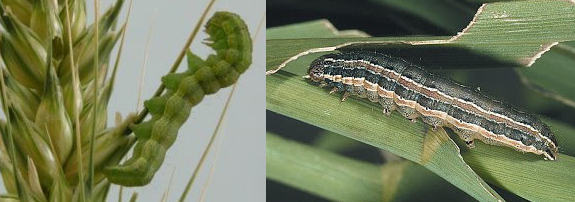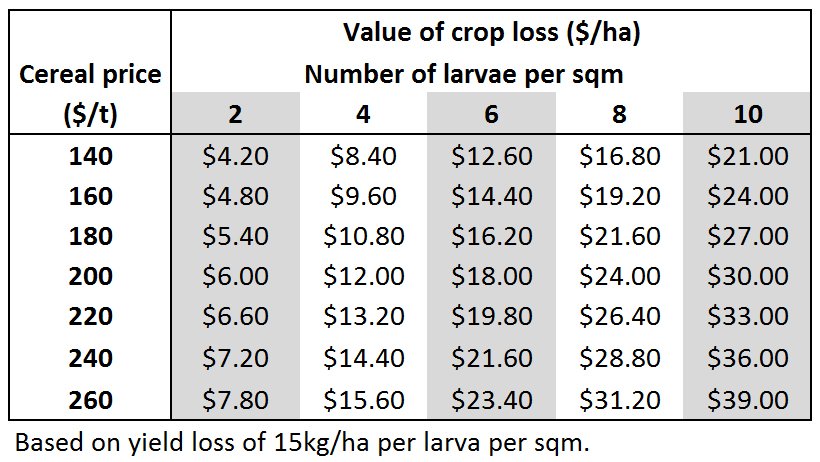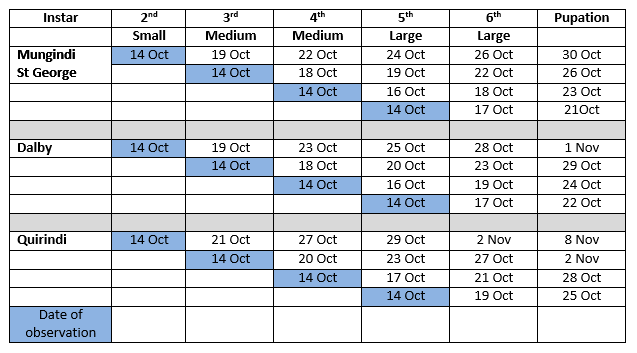Large flights of helicoverpa over the last 2 weeks (or longer in some districts) have seen significant eggs lays and larval populations in winter crops, including the winter cereals.
It is not unusual to find both corn earworm and armyworm in cereal crops. Correct identification of the species present is very important as it influences damage potential and choice of control measures.
Virtually all of the helicoverpa in cereals (barley, wheat, triticale, oats, canary) are the corn earworm, H. armigera. This is important to know because this species has developed resistance to many of the older insecticide groups that are registered for helicoverpa control in winter cereals.
Armyworm larvae (such as common armyworm Leucania convecta) are distinguished from corn earworm larvae by the presence of three pale stripes just behind the head, and by their smooth skin, without any hairs or bumps. While corn earworm will be active on the crop day and night, most armyworm will shelter on the ground during the day and feed at night.
Corn earworm do not cause the typical head-cutting of armyworms as seen in ripening barley crops.

Corn earworm (left) and common armyworm (right)
Corn earworm life history
Larvae hatch from the eggs in 3 to 5 days and develop through the grain fill stage over 14 to 28 days, depending on temperature (see larval development tables at the end of the post).
In crops where the grain is mature and drying down, larvae tend to graze on the grains. In crops where the grain is still filling (milky-soft), larvae have the potential to burrow into the grain and consume the majority of it. It is unclear when larvae will stop feeding on grain (what moisture content), but it is unlikely that crops within a week or so of harvest will suffer significant losses. Around 80% of the total feeding will be during the final two instars. Very small and small larvae probably feed on leaf material, the older larvae moving onto the heads and feeding on the grain.
In most crops, very small and small larvae have very high rates of mortality (death). We don’t know exactly what this is for winter cereals, but it is safe to assume that there will be at least 30% mortality of VS-S larvae. In other words, in making management decisions use 70% of the VS-S larval count in calculating crop loss and when comparing field counts with thresholds.
When mature, larvae drop to the ground and pupate in earthen cells.
Damage
How much damage do corn earworm larvae cause to cereals? There are currently no data from cereals on which to base this decision, but in the past extrapolation from the old sorghum damage value (1.5 g grain loss per larvae) has been used as a guide.
To put this damage value into perspective, there are some comparative data for other crops. The damage value for sorghum was recently revised upwards from 1.5 to 2.4 g per larva. The value for chickpea is 2.0 g per larvae, and the latest mungbean value is 3.5 g per larva. Using the old sorghum value (1.5 g per larva) is not unreasonable and may be on the conservative (low) side, but it provides sound guidance for decision-making.
Based on the preceding information, we can make an estimate of what represents a problem. One larvae per m2 potentially causes 15 kg grain loss/ha (based on the figure of 1.5 g/larva eaten). Table 1 below shows the value ($/ha) of potential grain loss caused by helicoverpa feeding. The table shows, in economic terms, the impact of feeding damage.
Table 1. The value of lost yield as a result of helicoverpa feeding in wheat.
Where the cost of control exceeds the value of the potential loss, treatment is not recommended. At the break even point (when the cost of control = value of the potential yield loss), treatment is also not recommended as there is no potential economic gain to be had (cost: benefit = 1:1). A rational economic decision is generally made by applying a cost:benefit factor to the equation. A benefit:cost ratio of 1.5 is common and means that the projected economic benefit of the spray will be 1.5 times the cost of that spray.
Estimates of economic thresholds, based on any your specific costs of control and expected grain price can be made using the formula: ET = (C x 1000) / (D x P)
Where
- C = cost of control ($/ha) (insecticide + application)
- D = grain consumption figure per larva (t/ha). In this case we have used 1.5 g/larva per square metre (15 kg/ha for each larva per sqm).
- P = expected grain price ($/t)
The tables below show the estimated economic thresholds for a range of values.
Table 2. The economic threshold for helicoverpa in wheat (with a 1.5:1 benefit:cost applied).
Table 3. The break-even economic thresholds for helicoverpa in wheat (1:1 cost benefit = break-even). Control decisions are not recommended at break-even values, or below.
It should also be remembered that larval damage is irrespective of yield potential of the crop i.e. each larva will eat its fill whether the expected yield is 1 or 3 tonne/ha.
Sampling and management
In many cases corn earworm larvae are not identified in cereals until they are medium or large in size (i.e. >7 mm in length). This has implications for their management. Just walking through the crop and making visual inspections of the heads is likely to severely underestimate the number of larvae in the crop. Reports from agronomists show that beatsheet sampling is the best way to get an estimate of what is in the canopy, and on the heads.
Using a beatsheet not only gives a more accurate estimate of the total population, it will also allow you more time to consider options and react, before you have medium-large, damaging larvae that are difficult to control with available options.
Options for control
As corn earworm have historically had high resistance to pyrethroids, a pyrethroid is unlikely to provide satisfactory control, particularly if larvae are greater than 5 mm in length. While resistance levels to pyrethroids may have declined in recent years, control of medium-large corn earworm larvae using pyrethroids is not recommended.
Methomyl is another registered option at 1.5 to 2.0 L/ha, with the higher rate against larvae greater than 20 mm in length. It has contact action only (no residual), but that is not a problem because reinfestation is most unlikely. Resistance to carbamates (methomyl) has been a problem in the past, so any decision to use this product should be based on its recent performance against pest infestations.
In situations where both corn earworm and armyworm are present, carefully assess the relative abundance of each. Head-cutting activities of large armyworm larvae in ripening barley crops can be very serious and require prompt action. While registered pyrethroids may be a preferred option for armyworm, they are unlikely to have much impact on corn earworm larvae. Methomyl is also registered for both pests in wheat and barley. As armyworm mostly feed at night, spraying at dusk is recommended for best results.
NPV (Vivus Max®) is effective against Helicoverpa armigera at a 75-100 mL rate. If most of the larvae in a wheat crop are less than 10 mm (medium); then NPV is an option for control. Look to apply NPV in the warmer part of the day and the inclusion of Optimol® may increase the efficacy against larger larvae.
Always read the label and abide by relevant withholding periods and export grazing/slaughter intervals where feeding to stock may be involved.
Many natural enemies (predators, parasites and pathogens) attack corn earworm larvae. Where winter cereals have been previously treated with broad spectrum insecticides to control aphids, fewer natural enemies may be present and survival of caterpillar pests could be greater than normal.
Timing of control and implications
With the limited options for control, and the potential for reduced efficacy because of resistance, there are a number of considerations when it comes to control.
If crops are still green and 4-6 weeks from harvest, small larvae will have time to develop to a damaging size before the crop is less susceptible to damage (see development rate table below). In these crops, if there are large populations of small larvae, the use of NPV has merit, either on its own or in combination with another option.
One approach would be to treat above threshold populations early (when larvae are smaller and down in the canopy, but potentially more susceptible to the insecticide). Using a ground rig with medium droplets, 80-100L water and insecticide rates at the higher end of what is registered is likely to give the best outcome in this scenario.
Alternatively, waiting until larger larvae are more exposed on the heads may make aerial application more viable, but does run the risk of lower efficacy because of difficulty getting penetration into the canopy, resistance; and risks incurring grain loss before the control is implemented.
Larval development rate tables
The DARABUG model was used to predict the rate of larval development for three locations (Dalby, Mungindi/St George, Quirindi). Note that these tables are indicative only, and could vary slightly from the predictions depending on the actual temperatures experienced.
To use the table below,
- select location on the right hand side
- select a larval size (instar) that corresponds to that in your wheat on 14 October
- read across the table from 14 October, to see when larvae will be damaging (5th-6th) and when they will stop feeding (pupation).




